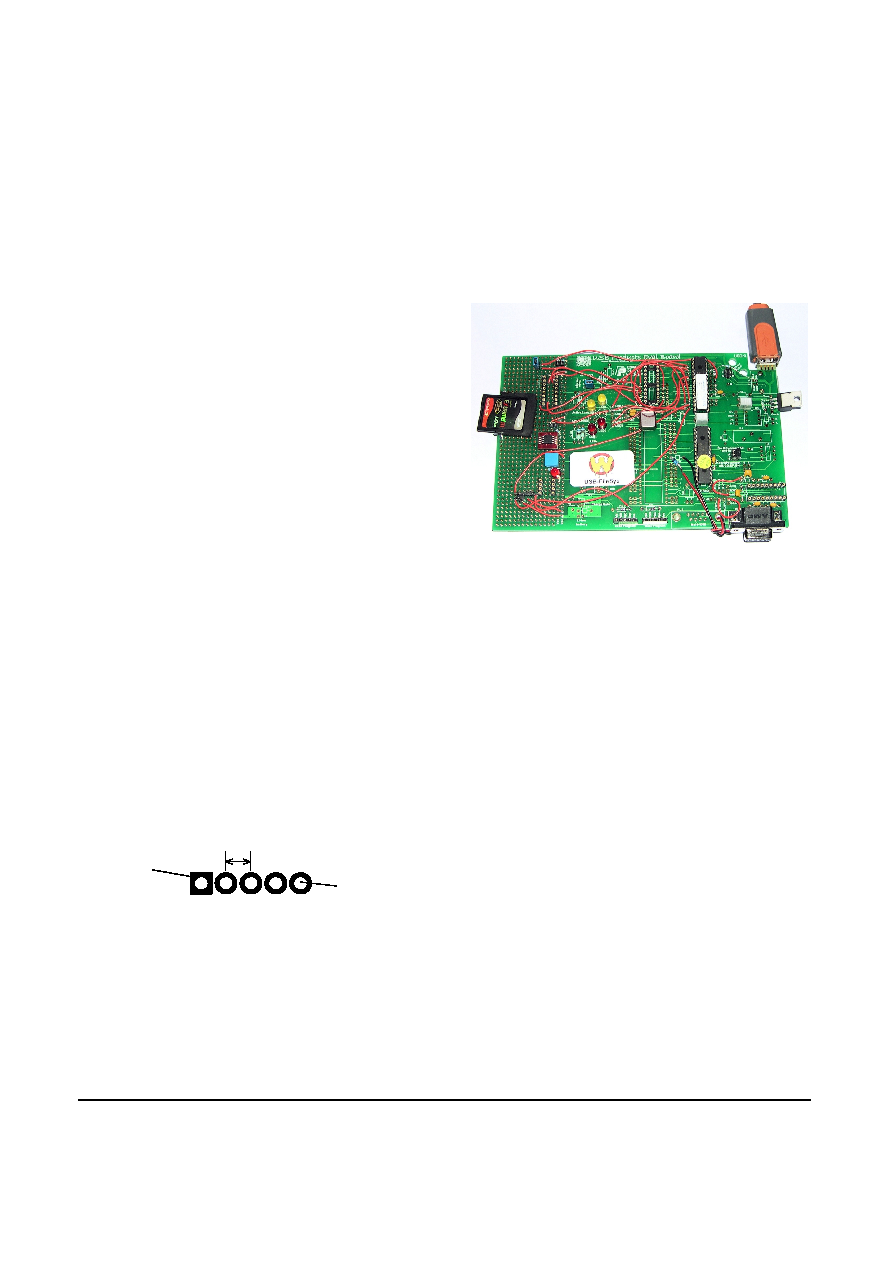- 您現(xiàn)在的位置:買(mǎi)賣(mài)IC網(wǎng) > PDF目錄4568 > USB-DAQ-SS (Flexipanel)IC SYSTEM DATA LOGGER 20-SSOP PDF資料下載
參數(shù)資料
| 型號(hào): | USB-DAQ-SS |
| 廠商: | Flexipanel |
| 文件頁(yè)數(shù): | 7/8頁(yè) |
| 文件大?。?/td> | 0K |
| 描述: | IC SYSTEM DATA LOGGER 20-SSOP |
| 標(biāo)準(zhǔn)包裝: | 25 |
| 系列: | * |
| 其它名稱: | 658-1042-5 |

p7 of 8
26-Aug-10
USB-DAQ
HW147-5
www.hexwax.com
Interrupt Processing
In addition to being triggered by the real time clock,
application code can be executed in response to an
interrupt event. Most interrupts are supported. Interrupt
priority should be set to high.
When an interrupt occurs, USB-DAQ will clear the
interrupt enable bit and pass control to the application
code. It is then the application code’s responsibility to
clear the interrupt flag and re-set the interrupt enable.
File Access
Up to four files can be accessed by the USB-DAQ. It
modifies the contents of these files but does not create
or delete them, or modify their length. They must be
copied from the PC for the application to execute.
When the end of the file is reached, the file pointer
wraps round to the beginning again (plus any header
space reserved.) All read and write operations must be
within the 512-byte sector boundaries of the files.
Therefore it is usual for logged records to be a power of
two in length.
Compiled Code
The code is compiled into a reduced instruction set
which is then interpreted at run-time. This compiled
code is shown in the spreadsheet.
TEAclipper Programming
For programming the firmware using TEAclipper/PIC HV,
the PGC, PGD and Vpp pins must be accessible.
During programming, these pins must be protected
against contention.
In particular, note that Vpp is
subject to up to 13V during programming. Nothing else
should be connected to Vpp except via a 22k pull-up
resistor.
The TEAclipper connector format is shown in figure 8.
Since the programming time is very fast,
no
programming socket is required. The TEAclipper can be
‘leaned’ against the plate-through holes shown.
It is strongly recommended that this connector is
included in circuits even if in-circuit programming is not
anticipated, since this allows you to upgrade the
firmware if necessary.
1mm hole dia
2.54mm spacing
Pin 1 indicated
by square pad
P
G
D
P
G
C
V
pp
V
ss
V
dd
Figure 8. Recommended plate-through connector design
Evaluation Board
The USB-Eval evaluation board is available for
evaluating USB-DAQ. Due to the variety of potential
implementations it is supplied unpopulated and a
prototyping area is provided. This will be necessary for
SD memory implementation (see Figure 9).
It is recommended that new users work with internal
memory to reduce the number of connections required
and then migrate it to test the circuit actually required.
Start, perhaps, with Figure 3 plus the 32768Hz oscillator.
Note
the
following
common
mistakes
during
development:
1.
Forgetting to press the ‘Compile Now’ button
before copying the CONFIG.DAT to USB-DAQ.
2.
SD memory needs 3.3V power regulation.
It is strongly recommended that an Escape pin is used,
since without it the USB-DAQ chip can be rendered
unusable.
Figure 9. Evaluation board example
Code Examples
The following examples are provided in the development
kit to illustrate USB-DAQ usage.
DigitalAnalog.xls
This example logs the time, the analog pins AN1 and
AN0, and digital pin RA2 every three seconds. RA4 is
used to power the sensor, and so illustrates how to set
an output high our low.
Interrupts.xls
This file shows how interrupts are handled. It sets up a
falling-edge interrupt on INT2. When an interrupt occurs,
it flashes an LED on RA5 and logs the time to the file.
The interrupt flag is then re-enabled and USB-DAQ
goes back to sleep.
AnniLogic.xls
This anniversary reminder application demonstrates
basic arithmetic and how to read files. It also illustrates:
- How long file names can be presented to the user
while USB-DAQ accesses them using their short file
names.
- The use of the preprocessor to create meaningful
variable names, and overlaying them to re-use
memory.
- Calling subroutines.
相關(guān)PDF資料 |
PDF描述 |
|---|---|
| NCP698SQ13T1G | IC REG LDO 1.3V .28A SC-82AB |
| HMC30DRAH-S734 | CONN EDGECARD 60POS .100 R/A PCB |
| LFXP20E-5F256C | IC FPGA 19.7KLUTS 188I/O 256-BGA |
| LFXP20E-4FN256I | IC FPGA 19.7KLUTS 256FPBGA |
| LFXP20E-4F256I | IC FPGA 19.7KLUTS 188I/O 256-BGA |
相關(guān)代理商/技術(shù)參數(shù) |
參數(shù)描述 |
|---|---|
| USBDESKTOP | 制造商:ETI Systems 功能描述:Joystick;3-Axis;10 Programmable Buttons;Desktop Housing;USB Connector |
| USBDESKTOP-01 | 制造商:ETI Systems 功能描述:Joystick |
| USBDF | 制造商:未知廠家 制造商全稱:未知廠家 功能描述:EMI FILTER AND LINE TERMINATION FOR USB DOWNSTREAM PORTS |
| USBDF01W5 | 功能描述:電磁干擾濾波器 EMI Filter/Line Term RoHS:否 制造商:STMicroelectronics 電容:12 pF 電路類(lèi)型: 最大直流電流: 最大直流電阻: 電壓額定值:6 V 容差: 端接類(lèi)型:SMD/SMT 工作溫度范圍:- 30 C to + 85 C 系列:EMIF03 |
| USBDF01W6 | 制造商:STMicroelectronics 功能描述: |
發(fā)布緊急采購(gòu),3分鐘左右您將得到回復(fù)。